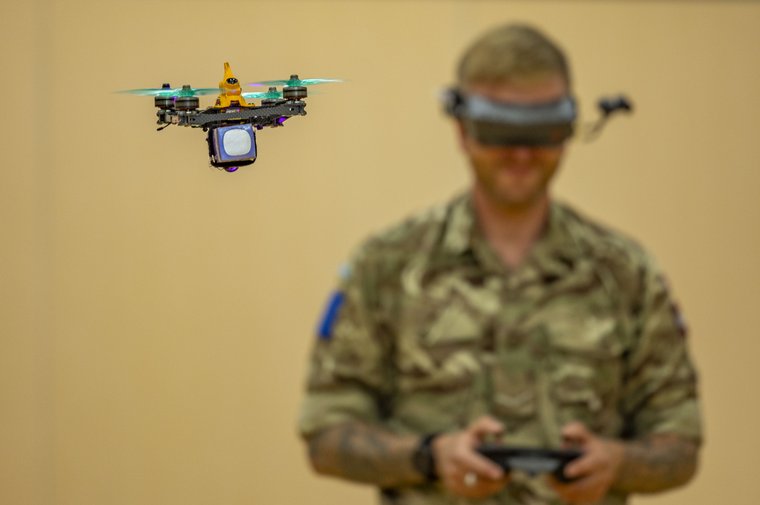British Army looks to ‘kamikaze drones for future operations
Details
More Products & Services
Products & Services
Shephard Plus Update
Shephard Media
Shephard Plus is updating in June 2018 with rich new capabilities, and is now one of the most cost-effective and valuable aerospace and defence market intell...
Military Unmanned Systems Handbook
Shephard Media
The Military Unmanned Systems Handbook (Digital Download) is an international guide to the military UV industry and provides detailed information on air, ground and sea (surface & sub-sea) vehicles as well as subsystems. What's included: Unencrypted 390+ page PDF of equipment and supplier information Market summary
Defence Insight
Shephard Media
Some of the things people like you use Defence Insight for:
- Total addressable market sizing ($)
- Competitor analysis
- Cost analysis
- Market forecasting
- Growth identification
- Increasing closing ratio
- Increasing closing order value
- Estimating product potential
- Calculating sales forecasting
- Supply and demand analysis
- Total addressable market sizing ($)
- Competitor analysis
- Cost analysis
- Market forecasting
- Growth identification
- Increasing closing ratio
- Increasing closing order value
- Estimating product potential
- Calculating sales forecasting
- Supply and demand analysis
Description
British Army soldiers have been working towards flying ‘kamikaze drones' on one-way missions as they look to emulate the successes of the Ukrainian Armed Forces in their war with invading forces from Russia.
The force has been testing the skills of its soldiers using First Person View (FPV) Uncrewed Aircraft Systems (UAS) as it develops a precision-strike capability.
Via Project Lewes, the Army's programme to incorporate new technologies and capabilities into existing forces, troops have been trained to fly FPV UAS for use on the battlefield for finding and striking targets.
FPV UAS could potentially replace the Parrot and Black Hornet UAS currently issued to the force's fighting units. These platforms, used for reconnaissance, feature capabilities missing from FPV drones such as GPS and stabilisation software.
“While it is harder to operate, an FPV UAS is a much simpler, more adaptable and cheaper bit of kit,” explained Sergeant Adam Barnes, a senior UAS operator in 2nd Battalion, Parachute Regiment (2 PARA). “With a skilled pilot and the right UAS, you can use them to strike targets as well as carrying out reconnaissance.”
Currently, operators of Parrot and Black HornetUAS complete a three-week course to qualify as pilots. The British Army has been running screening sessions to find soldiers among its UAS pilots to fly FPV UAS and join the UK Ministry of Defence Strategic Command's jHub Drone Academy to further develop their skills.
“An infantry unit equipped with FPV UAS can fly them to attack targets that it would otherwise have to call in mortars, artillery or an air strike to hit,” Barnes noted. “It shortens the kill chain and gives a commander more options, making for a more efficient use of resources.”
FPV UAS can by operated via virtual reality headsets and carry small explosive charges enhancing their manoeuvrability on the battlefield.
Related Equipment in Defence Insight
PD-100 Black Hornet
Anafi
The force has been testing the skills of its soldiers using First Person View (FPV) Uncrewed Aircraft Systems (UAS) as it develops a precision-strike capability.
Via Project Lewes, the Army's programme to incorporate new technologies and capabilities into existing forces, troops have been trained to fly FPV UAS for use on the battlefield for finding and striking targets.
FPV UAS could potentially replace the Parrot and Black Hornet UAS currently issued to the force's fighting units. These platforms, used for reconnaissance, feature capabilities missing from FPV drones such as GPS and stabilisation software.
“While it is harder to operate, an FPV UAS is a much simpler, more adaptable and cheaper bit of kit,” explained Sergeant Adam Barnes, a senior UAS operator in 2nd Battalion, Parachute Regiment (2 PARA). “With a skilled pilot and the right UAS, you can use them to strike targets as well as carrying out reconnaissance.”
Currently, operators of Parrot and Black HornetUAS complete a three-week course to qualify as pilots. The British Army has been running screening sessions to find soldiers among its UAS pilots to fly FPV UAS and join the UK Ministry of Defence Strategic Command's jHub Drone Academy to further develop their skills.
“An infantry unit equipped with FPV UAS can fly them to attack targets that it would otherwise have to call in mortars, artillery or an air strike to hit,” Barnes noted. “It shortens the kill chain and gives a commander more options, making for a more efficient use of resources.”
FPV UAS can by operated via virtual reality headsets and carry small explosive charges enhancing their manoeuvrability on the battlefield.
Related Equipment in Defence Insight
PD-100 Black Hornet
Anafi

Share
Recent Chats
Share via email
Future: handle WhatsApp here
Future: handle LinkedIn here
Future: handle Twitter here
SUBMENU HERE
Share via Chat
Copy Link



